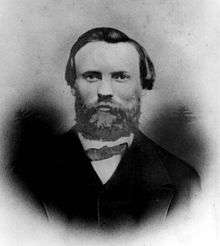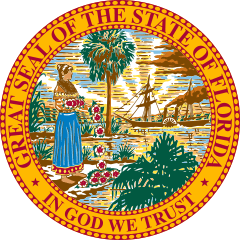William Henry Gleason
William Henry Gleason (June 28, 1829 – 1902)[1] was an American politician from Florida. He was Florida's second Lieutenant Governor and was very briefly, acting Governor.
William Henry Gleason | |
|---|---|
 | |
| 2nd Lieutenant Governor of Florida | |
| In office July 7, 1868 – December 14, 1868 | |
| Governor | Harrison Reed |
| Preceded by | William W. J. Kelly |
| Succeeded by | E. C. Weeks |
| Member of the Florida House of Representatives from Dade County | |
| In office 1871–1875 | |
| Preceded by | Isaiah Hall |
| Succeeded by | William Watkin Hicks |
| Personal details | |
| Born | June 28, 1829 Richford, New York |
| Died | 1902 (aged 72–73) Eau Gallie, Florida |
| Political party | Republican |
| Spouse(s) | Sara Griffin |
| Children | William Henry Hunt Gleason |
| Profession | Lawyer, real estate developer |
Early life
William Henry Gleason was born in 1829 in Richford, New York. He had an early interest in engineering, banking, law and politics. In 1855 he opened a bank and began to develop the town of Eau Claire, Wisconsin. In 1858 he married Sara Griffin from New York. Gleason learned from his banking experience and moved into sales during the Civil War.[2]
The issue of slavery was an interest of Gleason's, and having made a name for himself in this cause, he was appointed a special agent of the Freeman's Bureau in 1865. His mission was to scout the Florida peninsula as a possible site for a Negro colony.[3] The idea of colonization did not appeal to Gleason. His recommendation against a Negro colony in Florida garnered local political support in future years.[4]
Having toured the state for several months, Gleason was one of the first post-war visitors to realize the great potential for business. He rented a schooner and moved his family to the old military post, Fort Dallas, in 1866 (near present-day Miami). This was a time of great transition in Florida. Gleason sought investment land under control of the state's Trustee's of the Internal Improvement Fund and proposed to ditch and drain land in exchange for bargain rates on nearby real estate. The board originated in Congress with the 1850 Internal Improvement Act that granted certain swamp and overflow lands to the states. Florida received millions of acres, and not all was swamp. The mission of the Trustees of the Internal Improvement Trust Fund was to work with private companies to improve the state. Developers like Gleason were allowed to purchase 640 acres (260 ha) of state land for $40 in consideration for every 50,000 cubic feet (1,400 m3) of ditching completed. This amounted to just over six cents per acre and provided an 800% return on investment if the land could be resold at fifty cents per acre.[5]
In 1875 Gleason became interested in a canal project to connect Indian River with Lake Washington. He proposed to rechannel and deepen Eau Gallie's Elbow Creek and extend the waterway to Lake Washington. The state's payment for this work was set at $4000 plus 4,000 acres (1,600 ha) for every mile (10 km² per km) of canal constructed. This project never materialized, however a drainage canal was cut (the Hopkins ditch) along this route, named after its promoter George W. Hopkins.[6]
Politics
During the late 1860s and 1870s, Gleason traveled between his Fort Dallas residence and Tallahassee, seeking business and political connections. As a consequence of this and a few powerful Republican friends, on July 7, 1868,[7] he was sworn in as the state's second lieutenant governor. During an attempted impeachment of Governor Harrison Reed, Gleason claimed the Governorship. The Senate had adjourned on November 7, 1868 without deciding whether or not to impeach Reed. Reed's supporters, including the state's Adjutant General and the county Sheriff, kept him out of the Capitol. He set up in a hotel and signed documents as Governor. The Supreme Court sided with Governor Reed, and the political struggle ended with his removal from office as Lieutenant Governor December 14, 1868.[8]
Traveling along Florida's coast, Gleason passed many charming harbors. He liked one such area so much that he purchased most of it (16,000 acres (6,500 ha)) at $1.25 an acre and named it Eau Gallie. This was the site of Arlington, founded by John C. Houston. Gleason prepared a plat of his new land, which encompassed the entire area from Indian River Lagoon to Lake Washington, approximately thirty square miles. William Lee Apthorp's 1877 Standard Map of Florida shows Eau Gallie in large capital letters, incorrectly designating Gleason's land as the county seat of Brevard County. Part of Gleason's land eventually became the city of Eau Gallie, Florida and later north Melbourne.[9]
During the contentious 1876 presidential election, Gleason reportedly held up the certification of Florida's results. Shortly after the election, it was determined that there was a tie in Florida but also that the returns from Dade County had not been counted. After several attempts by the governor to obtain Dade County's returns, locals realized that Gleason had possession of them but had forgotten to mail them before going on a hunting expedition. The twenty-eight votes determined who Florida's electoral votes went for, though the final decision was ultimately made by a bipartisan commission who considered the returns from Florida, Louisiana, and South Carolina.[10]
Post Civil War
In 1871 Gleason proposed the idea of the state's first Agricultural College to be located in the Eau Gallie section of Melbourne, Florida. Gleason offered a 2,320-acre (940 ha) donation of intermittent swamp lands east of Lake Washington to the Trustees of the Florida Agricultural College if they would select Eau Gallie as the school's campus. Records indicate that Gleason later received $100 from the state for two Eau Gallie lots to be used as sites for college building. The site was approved and the two-story coquina building was completed in 1875, but it was never used for its intended purpose.
Remnants of the old campus are located off of present day Pineapple Avenue (formerly part of U.S. 1), north of Eau Gallie Boulevard. The college reemerged in the north Florida town of Lake City under Democratic leadership during 1884.
Sensing legal difficulties in Dade County, Gleason moved his wife and two teenage sons to the unused campus of Eau Gallie's Agricultural College during 1882 and 1883 and began a sawmill and boat building business. The Gleasons' took control of the old college building and lived there until they became established. By 1884, Henry and Sara had recorded the village plat of Eau Gallie and began selling lots in their new town.
The Florida State Agricultural College filed to foreclose on Gleason's claim to the vacant college building. After several years of litigation, the Trustees of the college were able to negotiate a settlement. Gleason's "donated" west Eau Gallie land was returned to him and, in exchange, the governor agreed to pay $2,000 for the small college building and campus. Gleason and his sons converted the building into the prosperous Hotel Granada during the 1890s. It served the typical tourists of the day, sportsmen seeking fish and game. The two-story coquina hotel was destroyed by fire in 1902. The charred building symbolized the end of an era which coincided with the death of the Lt. Governor the same year.[11] William Gleason's grandson William Lansing Gleason co-founded Indian Harbour Beach, Florida on June 6, 1955.
Footnotes
- "W. H. Gleason". Town of Jupiter [Florida].
- Cresse, Lewis. A Study of William Henry Gleason: Carpetbagger, Politician, Land Developer. 1979 PhD Thesis, Univ. of S. Carolina
- Cresse, p. 1-11.
- Cresse 1979, p.62-63.
- Eriksen, John M. Brevard County, Florida: A Short History to 1955
- Galbraith, John B.; Meek, A. R. (1869), Cases Argued and Adjudged in the Supreme Court of Florida, 12, Tallahassee: Edw. M. Cheney, p. 194, retrieved 2008-05-25
- Morris, Allen and Joan Perry Morris, compilers. The Florida Handbook 2007-2008 31st Biennial Edition. p. 312. Peninsula Publishing. Tallahassee. 2007. ISBN 978-0-9765846-1-2 Softcover ISBN 978-0-9765846-2-9 Hardcover
- Eriksen, p. 58-61.
- Sewell, John (1933). John Sewell's Memoirs and History of Miami. Miami: Franklin Press. pp. 160–161.
- Eriksen 2003, p. 74-75.
External references
- Gleason Family papers
- Brevard County Property Appraiser
- Melbourne Bicentennial Book. July 4, 1976. Noreda B. McKemy and Elaine Murray Stone. Library of Congress 76-020298
- Indian Harbour Beach Homepage
- Morris, Allen and Joan Perry Morris, compilers. The Florida Handbook 2007-2008 31st Biennial Edition. Page 312. Peninsula Publishing. Tallahassee. 2007. ISBN 978-0-9765846-1-2 Softcover ISBN 978-0-9765846-2-9 Hardcover.
- Political Graveyard - Death Information
- William Henry Gleason at Find a Grave
| Political offices | ||
|---|---|---|
| Preceded by William W. J. Kelly |
Lieutenant Governor of Florida 1868–1869 |
Succeeded by E. C. Weeks |
| Preceded by Isaiah Hall |
Member of the Florida House of Representatives from Dade County 1871–1875 |
Succeeded by William Watkin Hicks |
